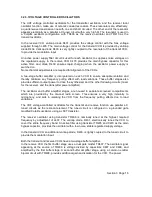
3.2.1.4.3
Path 3.
The final path for the demodulated receive audio, is to the pre-processing circuit for the tone
sequential signalling decoder.
The signal path of the demodulated audio may also be broken to include the noise blanker
circuit option fitted to SK401. When this is done R440 is deleted.
The fourth stage of OP AMP IC401 is used to provide a regulated bias voltage for the other
three OP AMPs within this IC.
3.2.1.5
AUDIO OUTPUT
The filtered receive audio is then passed via the volume control to the power amplifier IC202.
IC202 may have the output configuration re-arranged to provide a high power (16watV4ohm)
output. This results in a bridged output configuration with both speaker connections at roughly
half the supply voltage above ground. The speaker is then directly coupled to IC202. The
audible alert signal is coupled into the audio power amplifier via resistors R231, R232 and
R233. The ratios of these resistors may be set to provide some measure of alert tone
generation proportional to the volume control setting.
For systems applications a control input is provided on IC202 at PIN 8 to disable the
loudspeaker. Also for special applications, resistor R227 may be selected to provide a
minimum volume level feature.
3.2.2
Transmitter
The UHF transmitter power amplifier is shown in block diagram form in figure 3.4. The
amplification is achieved in four discrete stages. The first stage has an input of 20mW from the
transmit VCO. This becomes amplified by TR417 operating in class AB mode to a level of
approximately 200mW. Diode D443 provides temperature stability of the bias for this amplifier
stage. The next stage of amplification occurs in TR419 which produces up to 3 watts output.
This stage operates in class C mode and the output power is controlled by adjustment of the
collector supply voltage. The following stages of TR421 and TR422 provide 10 watts and 30
watts output power respectively, both devices operating in class C. Extensive use is made of
micro-strip impedance matching networks between stages. No mechanical tuning of the
impedance matching is required.
A power detector circuit at the output of the final power amplifier stage, is realized by detecting
the RF voltages appearing at each end of a lumped element equivalent of a quarter-wave
transmission line. The quarter wave line comprises L438, C609 and C610. The RF detection is
achieved by D438 and C607.
The rectified and filtered voltage is fed back to the inverting input of a comparator circuit using
OP AMP IC405. Here, the feedback voltage is compared to an adjustable reference voltage as
set by potentiometer R581. The output of IC405 controls the bias voltage to TR420 which in
turn adjusts the collector voltage to TR419, and hence the gain of this stage.
Section 3 Page 8
















































